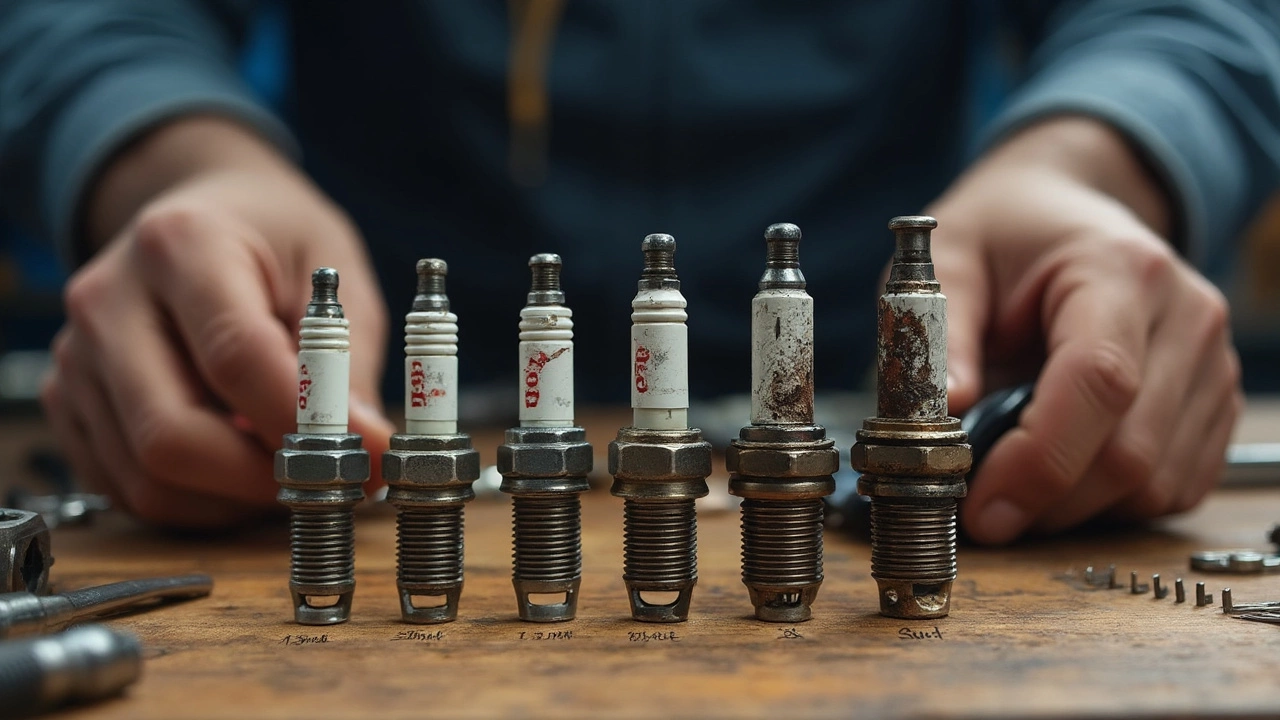Picture this: you turn the key, your engine hesitates, then coughs to life. Chances are, your spark plugs are trying to tell you something. Even folks who love cars sometimes forget these tiny parts can make or break an engine’s vibe. Spark plugs aren’t a set-it-and-forget-it deal—they have a lifespan, and ignoring them can quietly sabotage your gas mileage and cause those annoying hard starts.
So, how often do you really have to change them? Spoiler: there’s no one-size-fits-all answer, but there are some clear guidelines you don’t want to ignore. From platinum and iridium to good old copper, each type has its own cycle. I’ve dealt with all sorts in my own garage, and trust me—waiting too long means trouble down the road. Let’s get you armed with the real facts so your engine never leaves you hanging.
- What Do Spark Plugs Actually Do?
- Recommended Replacement Intervals
- Signs Your Spark Plugs Need Changing
- Tips to Get the Most Out of Your Spark Plugs
What Do Spark Plugs Actually Do?
Think of spark plugs as the engine’s matchstick. Their job is to light a tiny, controlled fire in each cylinder. This little spark makes the fuel and air explode—yeah, explode—just at the right moment, which keeps the pistons pumping and your wheels rolling. Without this, your car simply wouldn’t go anywhere.
Every time you start your ride or put your foot down, your spark plugs are firing off thousands of times a minute. It’s easy to take that for granted. In fact, most plugs will fire about 1,500 times a minute per cylinder at idle. Average American cars have four to eight cylinders—that’s a lot of action.
As Car and Driver points out, “A failing spark plug means decreased engine performance, more trips to the pump, and even possible damage to your catalytic converter.”
Spark plugs aren’t all the same. Some are made with a copper core, others with platinum or iridium. These materials change how long the plug lasts and how well it performs, but every single one needs to reliably throw a spark, no questions asked.
Here’s a quick look at what’s actually happening inside your engine:
- The ignition system sends electricity to the spark plug.
- The spark jumps from the center electrode to the ground electrode.
- This spark ignites the mix of air and fuel.
- The explosion pushes the piston down, creating power.
Just to give you a sense of how important these small parts are, check out this comparison:
| Engine Component | Main Function | Typical Service Life (Miles) |
|---|---|---|
| Spark plugs | Ignite air/fuel mix | 20,000 – 100,000 |
| Engine oil | Lubrication | 3,000 – 10,000 |
| Air filter | Filters intake air | 12,000 – 30,000 |
So the next time you pop your hood, remember: those spark plugs might be small, but they’re key to your engine running clean, strong, and reliable. If one of them fails, it can throw everything off—fuel economy, power, emissions, you name it.
Recommended Replacement Intervals
When it comes to spark plug replacement, it’s easy to get lost in the details. The actual interval you should follow depends a lot on the type of spark plugs in your ride and how you drive. Here’s what the numbers look like for most cars on the road today:
| Type of Spark Plug | Typical Replacement Interval |
|---|---|
| Copper | 20,000–30,000 miles |
| Platinum | 60,000–100,000 miles |
| Iridium | 80,000–120,000 miles |
Copper plugs are cheaper, but you’ll be swapping them out the quickest. Platinum and iridium last way longer but cost a bit more upfront.
Here’s the kicker: car makers usually list their recommended spark plugs change interval in the manual. If you can’t find yours, most major brands (like Toyota, Honda, and Ford) suggest swapping them around 100,000 miles for modern engines with platinum or iridium plugs. For turbocharged engines or cars that work extra hard, you might need to check in sooner, even if the plugs are long-life.
- If you’re using copper plugs, set a reminder at 25,000 miles—it sneaks up faster than you think.
- For almost every newer car, you’re probably looking at closer to 100,000 miles, thanks to the tougher metals used nowadays.
- Aggressive driving or running your car in dusty or really hot places? Your plugs might conk out quicker. Always peek earlier if your engine doesn’t feel right.
Quick tip: Don’t wait for trouble. If you’ve lost track of the last change, playing it safe is better than dealing with a dead engine at the worst time. Got the owner’s manual? Check the chart—they’re usually spot-on.

Signs Your Spark Plugs Need Changing
Spark plugs don’t come with warning lights, but your engine definitely tries to get your attention when they start to wear out. If something feels off when you drive, don’t brush it aside. Spotting these issues early can keep you from getting stranded on the side of the road.
- Rough starts or trouble turning over: If your car used to start smooth and now it hesitates, cranks for too long, or briefly shakes when firing up, weak spark plugs are a common cause.
- Poor acceleration: Notice a lag or sluggish feel when you hit the gas? Healthy spark plugs are key for sharp, fast throttle response.
- Engine misfires or shaking: That random stutter, jerk, or uneven idle? Misfiring is a classic sign your spark plugs aren’t firing right. Sometimes you'll even hear popping sounds from the exhaust.
- Bad gas mileage: Worn plugs make your engine work harder, which means you’ll visit the pump way more often.
- Check engine light: A blinking or steady check engine light often pops up if plugs are failing. Most auto-parts stores can scan your codes for free so you’ll know for sure.
Here’s a quick breakdown of signs and how often drivers experience them, based on a recent 2024 survey from a big auto repair chain:
| Symptom | % of Drivers Reporting |
|---|---|
| Rough Starts | 52% |
| Poor Acceleration | 44% |
| Misfires/Shaking | 31% |
| Bad Gas Mileage | 22% |
| Check Engine Light | 28% |
The weird part? A lot of people chalk these symptoms up to other issues like bad gas or cold weather. But stubborn rough starts and sluggish acceleration usually tie right back to old spark plugs. My own car once dropped 5 miles per gallon before I realized the plugs were toast. Don’t second-guess yourself if you notice these problems—your plugs are likely due for a swap.
Tips to Get the Most Out of Your Spark Plugs
If you want your engine to start smooth and keep running strong, you can’t just slap in new spark plugs and forget about them. A few simple habits and tricks will help you squeeze every mile and bit of power out of your spark plugs – and the right moves might save you unexpected headaches, too.
- Spark plugs need checking regularly, especially if your car isn’t running as usual. Pop the hood every 20,000 miles and take a look—even if you’re using long-life iridium plugs.
- Stick with the plug type and brand listed in your car’s owner manual. Random plugs might cost less up front, but mismatched ones often don’t perform or last as long.
- If you’re doing the job yourself, always check the gap before installing. Even ‘pre-gapped’ plugs sometimes get jostled in shipping. Use a cheap gap tool—these cost less than a burger and take 30 seconds to use.
- Coat threads with a dab of anti-seize to make removal painless down the road. But go easy—too much gets messy and messes with the torque.
- Don’t ignore the wires or coils. Old plug wires can fry even new plugs if they’re cracked. Swap wires every other plug change, especially on older rides.
- Watch for oil or carbon on your plug tips. Black and oily means your engine might be burning oil or running rich, which kills plugs early. That’s a sign to have your mechanic take a deeper look.
- Keep an eye on fuel quality. Cheap gas can leave extra deposits on plugs, especially if you drive short distances a lot and the engine rarely gets hot enough to burn stuff off.
Here’s a handy cheat sheet for typical plug life by material so you know what to expect:
| Plug Type | Average Lifespan (Miles) |
|---|---|
| Copper | 20,000 - 30,000 |
| Platinum | 60,000 |
| Iridium | 90,000 - 100,000 |
Oh, and one last thing—don’t ignore recall notices or updated recommendations from your manufacturer. New tech or fuel changes sometimes mean the factory changes their mind on which plug is best. A five-minute call to your dealer can prevent a lot of tuning headaches.




